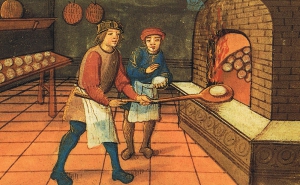A history of the apprentice
What do these pictures have in common?
They both show apprentices at work … more than 450 years apart!
Apprenticeships have been in the news recently, with widespread debate about the government’s target of 3 million apprenticeships by 2020 and the start of the Apprenticeship Levy next April.
But the apprenticeship system is not new by any means. The history of apprenticeships in England goes back to the Middle Ages, when young men (and young women in some trades, such as seamstress, cordwainer, baker or stationer) were ‘indentured’ for seven years to a master craftsman who not only taught them his trade but accommodated them in his household – usually as a servant – and had parental rights over them.
The first national apprenticeship system of training was introduced in 1563 by the Statute of Artificers (also referred to as the Statute of Apprentices), which set out the law relating to all trades and crafts, including apprenticeships. No one could practise a trade or craft in England without serving at least seven years’ apprenticeship. In Coventry, those completing seven-year apprenticeships with stuff (any manufactured material) merchants were entitled to become freemen of the city.
Apprenticeships back then
- An apprentice was not allowed to marry or start a household.
- A young person aged 12-20 could not refuse to become an apprentice if a householder of sufficient means demanded it, unless they were already apprenticed elsewhere.
- There were some bad masters – but if you left without another position to go to, you were considered a vagrant and could be imprisoned for up to 21 days, unless someone vouched for your reason for leaving. After that, you were whipped out of town as a vagabond.
- By the late nineteenth century, apprenticeships had spread from traditional trades to emerging sectors such as engineering and shipbuilding.
- During the 1960s and 70s, there were levy-funded apprenticeship programmes through industrial training boards, but no major reforms. Employers criticised the system as being too focused on time served, too restrictive and not meeting the needs of industry.
- In 1994, Modern Apprenticeships were introduced in response to government concerns about skills shortages, with an emphasis on qualifications rather than the length of time served. The programme evolved under various different names over the next 10 years, with national frameworks introduced in the early 21st century to set minimum standards for each apprenticeship.
- In 2004 the upper age limit of 25 was removed and pre-apprenticeships were introduced for people not ready to enter a full apprenticeship. Young Apprenticeships were also introduced for 14-16 year olds still in school.
Apprenticeships today
Higher Apprenticeships (equivalent to foundation degrees or above) were introduced in 2010 at the same time Young Apprenticeships were ended. March 2015 saw the introduction of Degree Apprenticeships, which differ from Higher Apprenticeships as they involve a degree as an integral part of the apprenticeship. Employers are involved in setting standards to replace the previous frameworks, to make sure they are relevant for the skills needed by industry.
Today, an apprenticeship must be a job in a skilled occupation which:
- requires substantial and sustained training, lasting at least 12 months and including at least 20% off-the-job training (though this can be in-house)
- develops transferable skills, including English and Maths, to progress careers
- leads to full competency and capability in an occupation, achieving an apprenticeship standard
- trains the apprentice to the level required for a professional qualification
Only training programmes which conform to these criteria can now be called apprenticeships.
Uni@Work offers Higher and Degree Apprenticeships delivered in the workplace and tailored to the business needs of individual employers. We also provide advice on the Apprenticeship Levy. For more information, please see the Uni@Work website.

